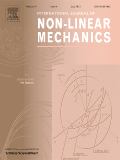
INTERNATIONAL JOURNAL OF NON-LINEAR MECHANICS
Scope & Guideline
Illuminating the Path of Non-Linear Mechanics
Introduction
Aims and Scopes
- Nonlinear Dynamics and Stability Analysis:
The journal extensively covers research on the dynamics of nonlinear systems, including stability analysis, bifurcations, and chaotic behavior. This area is crucial for understanding how systems respond to external forces and how they behave under different conditions. - Material Behavior and Characterization:
Research related to the mechanical properties and behavior of materials, especially under nonlinear stress-strain relationships, is a core focus. This includes studies on hyperelastic materials, viscoelasticity, and the effects of microstructural characteristics on macroscopic properties. - Computational Methods in Nonlinear Mechanics:
The journal publishes innovative computational techniques and numerical methods used to analyze nonlinear systems, such as finite element methods, perturbation techniques, and machine learning approaches for predicting nonlinear responses. - Applications in Structural Engineering and Mechanical Systems:
There is a strong emphasis on the application of nonlinear mechanics principles to real-world engineering problems, including structural analysis, vibration control, and the design of energy harvesting systems. - Interdisciplinary Research:
The journal encourages interdisciplinary studies that integrate concepts from mechanics, materials science, mathematics, and physics, reflecting the complex nature of nonlinear phenomena in various applications.
Trending and Emerging
- Nonlinear Control Systems:
There is an increasing focus on the development and analysis of nonlinear control systems, particularly in applications such as robotics and aerospace engineering. This trend highlights the need for effective control strategies in systems exhibiting nonlinear behavior. - Energy Harvesting and Vibration Mitigation:
Research on nonlinear energy harvesting techniques and vibration mitigation strategies is on the rise. This includes the design of novel devices that exploit nonlinear dynamics to enhance energy capture and reduce unwanted vibrations in engineering applications. - Machine Learning in Nonlinear Mechanics:
The integration of machine learning techniques for predicting and analyzing nonlinear behaviors is gaining traction. This emerging theme reflects the journal's commitment to embracing innovative computational approaches that enhance traditional methods. - Multiscale Modeling:
There is a growing interest in multiscale modeling approaches that connect microscopic material behavior to macroscopic structural responses. This trend is crucial for accurately predicting the performance of advanced materials and complex structures. - Nonlinear Dynamics in Biological Systems:
Research exploring the nonlinear dynamics of biological systems is becoming more prominent, reflecting an interdisciplinary approach that applies mechanics principles to understand biological phenomena and interactions.
Declining or Waning
- Linear Dynamics:
There has been a noticeable decline in papers focused on linear dynamics as researchers increasingly explore the complexities and advantages of nonlinear approaches. This shift reflects a growing recognition of the limitations of linear models in capturing the behavior of real-world systems. - Traditional Material Modeling:
Studies centered around conventional material models, such as basic elasticity theories, have seen a decrease. The trend is moving towards more sophisticated models that account for nonlinear behavior and complex material responses. - Static Analysis Without Nonlinear Considerations:
Research focusing solely on static analysis without incorporating nonlinear effects is becoming less prevalent, as the community recognizes the importance of dynamic and nonlinear factors in accurate modeling and analysis.
Similar Journals

COMPUTATIONAL MECHANICS
Elevating Research Standards in Computational MechanicsCOMPUTATIONAL MECHANICS, published by SPRINGER, is a premier international journal that focuses on the intersection of applied mathematics, engineering, and computational methods. With a commendable Q1 ranking in multiple categories, including Applied Mathematics and Mechanical Engineering, this journal is pivotal for disseminating groundbreaking research and innovative methodologies that advance the field. The journal has steadily contributed to the academic community since its inception in 1986 and continues to lead discussions and practices in computational mechanics and related disciplines. With a robust impact reflected in its Scopus rankings—placing it within the top percentiles across various categories—COMPUTATIONAL MECHANICS serves as a crucial platform for researchers, professionals, and students seeking to explore and contribute to significant advancements in computational theory and mathematical applications. Although it does not currently operate under an open access model, the journal ensures wide accessibility through libraries and institutional subscriptions, fostering a rich exchange of knowledge in the global scientific community.
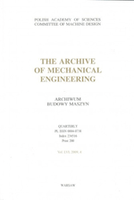
Archive of Mechanical Engineering
Pioneering Research in Engineering ExcellenceThe Archive of Mechanical Engineering, published by Polska Akademia Nauk (Polish Academy of Sciences), is a distinguished platform for disseminating cutting-edge research in the fields of Mechanical Engineering and Mechanics of Materials. Since its inception, the journal has evolved and embraced an Open Access model since 2010, thereby enhancing accessibility and fostering wider dissemination of knowledge among researchers, professionals, and students globally. The journal covers a broad spectrum of topics, ensuring that vital advancements in mechanical engineering are communicated effectively. Recognized as a Q3 category journal in both its relevant categories as of 2023, the Archive continues to establish itself with a competitive Scopus Rank, aiming to elevate the standard of research and innovation. By merging historical insights with contemporary advancements, the journal serves as an essential resource for those seeking to delve into the evolution and future of mechanical engineering.
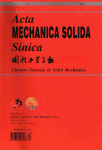
ACTA MECHANICA SOLIDA SINICA
Pioneering Insights in Computational and Mechanical EngineeringACTA MECHANICA SOLIDA SINICA is a prestigious journal published by Springer, dedicated to advancing research in the fields of Computational Mechanics, Mechanical Engineering, and Mechanics of Materials. Since its inception in 1981, the journal has established a significant presence in the academic community, holding a commendable Q2 ranking across its categories as of 2023. Furthermore, it is recognized for its impactful contributions, with Scopus rankings placing it in the top quartiles, fostering essential discourse among professionals and researchers in the engineering domain. While it operates under a traditional access model, ACTA MECHANICA SOLIDA SINICA continues to provide valuable insights and developments, making it an essential resource for those seeking to deepen their understanding of solid mechanics and related disciplines. The journal remains an influential platform for innovative theoretical and experimental studies, reinforcing its status in the global academic landscape.

ARCHIVES OF MECHANICS
Unleashing Innovation in Mechanical Engineering and Materials ScienceArchives of Mechanics, published by the Polish Academy of Sciences Institute of Fundamental Technological Research, is a distinguished open-access journal established in 1971 that has played a pivotal role in the dissemination of knowledge in the fields of Mechanical Engineering and Condensed Matter Physics. With its commitment to accessibility since adopting open access in 2022, this journal provides a platform for researchers, professionals, and students to share cutting-edge research findings and innovative methodologies. Although it currently holds a Q4 ranking in Condensed Matter Physics and a Q3 ranking in Mechanical Engineering for 2023, its comprehensive scope, which spans critical advancements in mechanical systems and materials science, positions it as a valuable resource for the academic community. Located in Warsaw, Poland, the journal continues to contribute significantly to the global discourse on mechanics and is dedicated to fostering new ideas that advance both theoretical and applied aspects of the discipline.
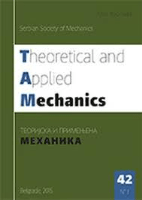
Theoretical and Applied Mechanics
Unlocking the Potential of Computational Mechanics.Theoretical and Applied Mechanics is a premier open-access journal published by the Serbian Society of Mechanics, dedicated to advancing the fields of Applied Mathematics, Computational Mechanics, and Mechanical Engineering. Since its inception, this journal has provided a vital platform for researchers and practitioners to publish high-quality, peer-reviewed articles that contribute to our understanding of theoretical concepts and their practical implications in mechanics. With an ISSN of 1450-5584 and a growing international readership, Theoretical and Applied Mechanics aims to bridge the gap between theory and application, making significant strides in the engineering community. Although the journal is currently ranked in the Q4 category across its scopes, it encourages innovative research that fosters interdisciplinary collaboration. For those interested in exploring cutting-edge developments in the mechanics field, this journal offers an invaluable resource for researchers, professionals, and students alike.

Forces in Mechanics
Unlocking the Secrets of Forces in MotionForces in Mechanics is a premier open access journal published by ELSEVIER that has carved out a significant niche in the realms of Mechanical Engineering and Mechanics of Materials. Established in 2020 and based in the Netherlands, this journal aims to disseminate high-quality research that explores the fundamental principles and applications of forces within mechanical systems. It operates under the ISSN 2666-3597, showcasing a dedication to transparent and accessible research for scholars around the globe. With a 2023 impact factor ranking placing it in the Q2 quartile for both Mechanical Engineering and Mechanics of Materials, the journal is recognized for its contributions to the field, evidenced by its Scopus ranking—285th in Mechanical Engineering and 184th in Mechanics of Materials, placing it in the 57th and 53rd percentiles, respectively. The journal publishes original research articles, reviews, and technical notes, catering to a diverse audience including researchers, practitioners, and students who are keen to advance their knowledge on the dynamics of forces in mechanical contexts. As it converges from 2021 to 2024, Forces in Mechanics remains committed to providing a platform for innovative research and critical discourse, ensuring that all published work is freely available to the global community.
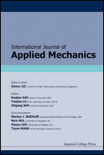
International Journal of Applied Mechanics
Fostering Collaboration in Applied Mechanics ResearchThe International Journal of Applied Mechanics, published by World Scientific Publishing Co Pte Ltd, is a premier platform that serves the fields of materials science, mechanical engineering, and mechanics of materials. Located in Singapore, this journal has established itself as a crucial resource for researchers, professionals, and students, with its convergence of scholarly work from 2009 to 2024. Ranked in the Q2 category across notable disciplines, including Materials Science, Mechanical Engineering, and Mechanics of Materials, it reflects a strong commitment to publishing high-quality research that pushes the boundaries of knowledge in applied mechanics. Despite being a non-open access journal, its successful Scopus rankings, including an impressive rank of #151 in Mechanical Engineering, signify its substantial impact and recognition within the academic community. This journal not only aims to disseminate pioneering research but also to foster collaboration and innovation in the rapidly evolving landscape of applied mechanics.
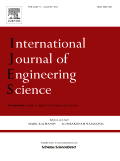
INTERNATIONAL JOURNAL OF ENGINEERING SCIENCE
Pioneering Innovations in Engineering and Materials ScienceInternational Journal of Engineering Science, published by Pergamon-Elsevier Science Ltd in the United Kingdom, stands as a premier platform for pioneering research in the diverse fields of engineering and materials science. Since its inception in 1963, this journal has consistently demonstrated its commitment to advancing academic discourse, maintaining an impressive trajectory that positions it in the Q1 category across multiple engineering disciplines including Mechanical Engineering and Mechanics of Materials as of 2023. With notable Scopus rankings—placing it in the top 5% percentile for Mechanical Engineering and related fields—this journal attracts high-quality, impactful research designed for both industry practitioners and academic scholars. Although it does not currently offer Open Access options, its readership is enriched by comprehensive peer-reviewed articles, fostering a deeper understanding of complex engineering problems and innovative solutions. The International Journal of Engineering Science continues to be an invaluable resource for researchers, professionals, and students committed to pushing the boundaries of knowledge in engineering and materials science.
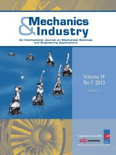
Mechanics & Industry
Shaping the Future of Mechanics and ManufacturingMechanics & Industry, published by EDP SCIENCES S A, is a prominent open access journal dedicated to the fields of Industrial and Manufacturing Engineering, Materials Science, and Mechanical Engineering. Since its establishment in 2004, the journal has served as a crucial platform for disseminating innovative research and developments in mechanics, catering to a diverse audience of researchers, professionals, and students worldwide. With an ISSN of 2257-7777 and an E-ISSN of 2257-7750, the journal is indexed in Scopus and has achieved a respectable Q3 quartile ranking across its categories for 2023. Mechanics & Industry emphasizes the importance of collaborative research and the sharing of knowledge, underpinning advancements in technology and industry practices. The journal's commitment to open access ensures that research findings are available to all, promoting sustainability and innovation within the global engineering community. Located in Les Ulis, France, this journal continues to uphold high standards of scholarly excellence and relevance in an ever-evolving industrial landscape.
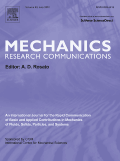
MECHANICS RESEARCH COMMUNICATIONS
Transforming Ideas into Engineering BreakthroughsMECHANICS RESEARCH COMMUNICATIONS, published by PERGAMON-ELSEVIER SCIENCE LTD, is a prestigious journal in the fields of Civil and Structural Engineering, Condensed Matter Physics, Materials Science, and Mechanical Engineering. With an ISSN of 0093-6413 and E-ISSN of 1873-3972, it has made significant contributions to the understanding and advancement of mechanics and materials since its inception in 1974. The journal is well-regarded in academia, holding a Q2 ranking across multiple categories as of 2023, and ranking in the 65th percentile for Mechanical Engineering. Researchers and professionals benefit from its peer-reviewed content, which includes a wide range of articles from fundamental research to applied technological developments. Although currently not an open access journal, it remains a vital resource for those focused on innovating within the engineering and materials science domains. With its established legacy, MECHANICS RESEARCH COMMUNICATIONS continues to shape the discourse in mechanics and engineering, making it essential reading for students and practitioners alike.